The Quick Answer
In the last few years, the popularity of hiking boots has decreased, and many hikers and backpackers have switched to low-cut hiking shoes or trail runners. These are indeed lighter than hiking boots and often provide better breathability. However, hiking boots also have certain advantages over the lighter alternatives. There has been a lot of debate on various hiking forums which type of footwear is better for hiking and it seems that the partakers can’t come to a clear conclusion. This makes sense, because in my experience footwear should be selected according to the terrain, expected weather conditions and the characteristics of the individual hiker.
I own a pair of proper hiking boots (Salewa Mountain Trainer Mid) as well as a pair of low-cut hiking shoes (Lowa Innox GTX TF). I haven’t and don’t plan to purchase trail runners because I don’t believe that they can provide me with the stability and durability that I need for the type of hiking trails I tend to gravitate towards. In the following I will explain the main differences between hiking boots, hiking shoes and trail runners to help you choose the right footwear for your needs. As hiking footwear varies a lot in terms of weight, materials and other specifications, I recommend also reading our Guide to Hiking Footwear.
Note: I no longer use Lowa Innox GTX TF hiking shoes. I replaced them with Lowa Renegade GTX.
Table of Contents:
Stability and Ankle Support
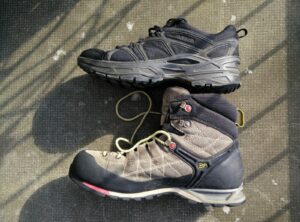
Stability and Ankle Protection – Hiking Shoes don’t come over the ankles and thus they provide no ankle protection whatsoever!
Ankle support is especially important for heavier hikers and beginners who are not yet accustomed to walking on uneven terrain. Nevertheless, ankle support is also very important for hiking on rocky terrain and carrying a heavy backpack. In such circumstances I always wear hiking boots rather than hiking shoes. I believe that that’s why I’ve never come home with a sprained ankle and I do spend a lot of time on hiking trails. Some very experienced and slim/light (I’m not one of them) hikers might be okay wearing trail runners in such circumstances but the majority will be better off in hiking boots. Hiking boots unquestionably provide the best stability and ankle protection. In fact, hiking shoes and trail runners provide no ankle protection at all as they don’t come over your ankles.
When it comes to stability, it’s a bit trickier because stability depends a lot on the midsole. For example, my Lowa Innox hiking shoes are very stable because they have polyurethane midsoles. However, most hiking shoes and trail runners have EVA midsoles (lightweight but soft) and therefore they don’t provide as good stability. Generally speaking, hiking boots provide better stability than hiking shoes or trail runners, but if you really want super stable footwear check the midsole material – polyurethane is a synonym for stability.
Durability

Durability – The lighter the footwear, the less it will withstand. On the photo my girlfriend’s running shoes after a hike in Iceland.
If the footwear is made properly (sturdy stitches and high-quality glue), its durability depends mostly on the materials. The most common materials for hiking footwear are different variants of leather and synthetic materials. Leather is obviously sturdier and more durable than most synthetic materials. Trail runners are never made of leather because leather is too heavy for such footwear. Therefore, I recommend avoiding trail runners for hiking on rough or rocky terrain where they might be subject to abrasion. The same goes for synthetic hiking shoes and boots. If you are planning to hike on rough terrain go for footwear with leather uppers. As for relatively smooth trails (forest trails, paved nature trails etc.), footwear made of synthetic materials is a better choice due to the lighter weight.
Another thing to consider when it comes to durability is the midsole. If you often carry a heavy load, you probably want more robust footwear as the extra weight will entail increased wear and tear with time. The midsoles on hiking shoes and trail runners are not designed to withstand heavy loads for longer periods and will quickly become flat (i.e. lose cushioning).
Breathability
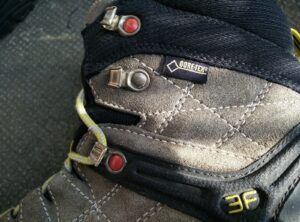
Breathability – Leather is less breathable than synthetic materials. Gore-Tex makes breathability even worse!
Like durability, breathability depends more on the materials than on the exact type of footwear. High-quality synthetic uppers will obviously be more breathable than leather uppers and non-waterproof uppers will be more breathable than waterproof uppers (for example Gore-Tex). However, in any case hiking boots come higher on your leg (typically over the ankle) and thus cover more skin. Despite that all my hiking footwear is waterproof, I recommend avoiding waterproof footwear unless you really need it. Gore-Tex lining drastically decreases the breathability. My Lowa Innox shoes are made of synthetic materials but they don’t offer much better breathability than my Salewa hiking boots which have leather uppers. The reason for this is obviously the Gore-Tex lining.
Weight
Trail runners are in most cases lighter than hiking shoes, which are again lighter than hiking boots. Weight is important because it impacts your comfort as you hike. Furthermore, the heavier apparel and gear you are wearing/carrying, the higher will your heart rate be (see my experiment). While you hike, you want to keep your heart rate between 50% and 70% of your maximum heart rate as you can endure for longer in this heart rate zone. You certainly don’t want to exhaust yourself in one hour on a seven-hour hike. So, if the circumstances (terrain, weather etc.) allow you, trail runners are a great option due to their low weight.
Traction
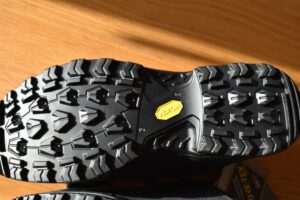
Lowa Renegade Shoes: Vibram EVO TRAC outsole is equipped with deep lugs and provides good traction. So deep lugs are not a standard when it comes to hiking shoes.
Hiking boots typically provide better traction than hiking shoes, which again provide better traction than trail runners. Hiking boots normally have thick and deep lugs that bite well into soil and their outsoles are made of rubber that grips perfectly onto rocky surfaces. Hiking shoes usually feature less aggressive lugs and less sticky rubber outsoles because they are primarily designed for hiking on forest trails and paved nature trails.
Trail runners are designed for running (albeit in slightly rougher terrain than normal running shoes) and therefore they often don’t have the same level of traction when you are hiking. When you are hiking, you apply less force on the outsole than when you are running due to your pattern of movement, and trail runners are designed to provide traction when large force is applied.
Conclusion
So, should you buy hiking boots, hiking shoes or trail runners? If you plan to hike on rough trails or carry a heavy load, hiking boot are the obvious choice. They are also perfect if you want to be able to go on any type of terrain without having to worry that they won’t hold up in terms of durability and stability. If rocky trails and heavy backpacks aren’t your thing, and you plan to mostly hike on forest trails – buy a pair of hiking shoes instead. Hiking shoes are more comfortable for such trails. Furthermore, they are also lighter. If you are mostly into paved nature trails or a lean experienced hiker who can afford to change footwear every year or two, you could probably go with the trail runners.
What type of footwear do you prefer for hiking? Drop me a line the comments section below.
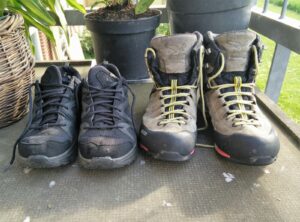
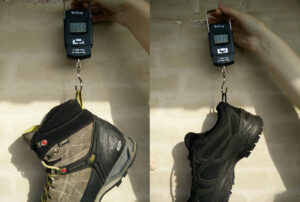
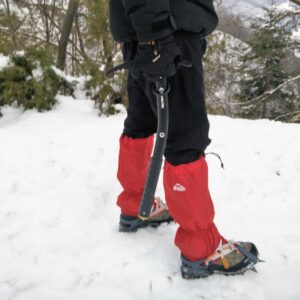




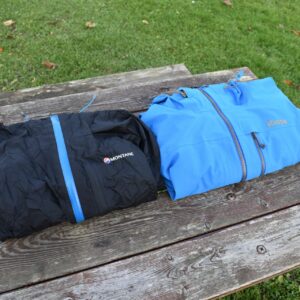
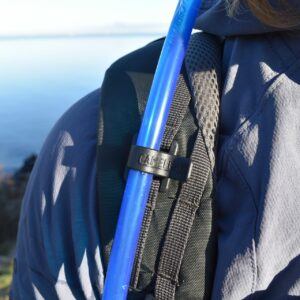
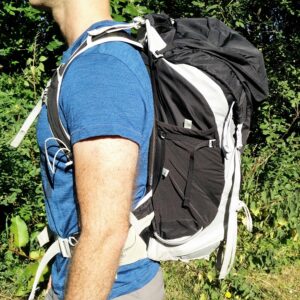

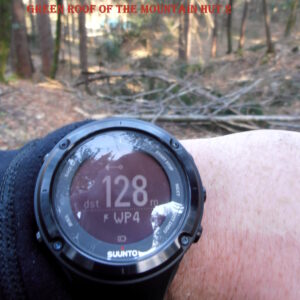











Great article and tips! Thanks Blaz 🙂
Happy you liked it! 🙂
“Hiking Boots vs. Hiking Shoes vs. Trail Runners: …..I haven’t and don’t plan to purchase trail runners ”
How can you compare the three, then?
I have used all three for backpacking on and off track and there are pros and cons to each.
You can wear trail runners off track, no question.
The capabilities of the sole, the weight and the fit makes the biggest difference.
Hi Sean,
Last time when I was buying hiking shoes, I also considered trail runners and I investigated/tried quite some models. I decided against trail runners because Lowa Innox hiking shoes seemed much more durable and stable, and for that I was willing to sacrifice some grams in terms of weight 😊 I agree that trail runners can be worn for backpacking and I also wrote that in the article. However, I prefer boots for backpacking and mountaineering because they did save my ankles several times in the past (maybe I’m just clumsy? 😊). Nevertheless, I get your point. Thanks for sharing your experience.
Dedicated trail shoes have better grip in mud due to deeper soles but grip is also a factor of sole rubber hardness. Many trail runners excel in this area over trail shoes. Trail shoes I think are mre durable though.
Weight is an overlooked area that you civer well in this blog. I did the calculations based on the available research and 100 g on the feet has the physiological cost of 600g on your back. Those heavy boots are costing you fatigue…
Thanks for the blog. It is good reading.
I stumbled upon similar research results in one of the books about backpacking. I also did an experiment in which I investigated how backpack’s weight influences heart rate here: https://nailthetrail.com/why-hike-lightweight/ Weight is indeed important.
I have hiked, backpacked and climbed for several decades and was also part of a mountain rescue unit in Colorado in the 1970’s. I’ve used just about every imaginable footwear for hiking and backpacking and until a few years ago would not have even considered backpacking without my heavy leather Asolo boots. My son and i did a 40 mile backpack trip and because of unusually high snowpack streams were still very high and fast in mid-August in Montana. I was wearing Gore-tex lined boots and, for safety, we had to wear them for nearly every stream crossing. The boots never dried out during the trip and never fit right afterwards. After wearing trail running shoes for some slot canyon hiking last year I’ve switched and now wear mid-height trail running shoes for hiking and backpacking. I can walk through water and they dry in a few hours. I’ve used them on trails that were barely trails, rocky trails, scree slopes, steep slopes and gentle grades. I’ll never go back to heavy boots. I know they won’t be as durable but I can afford to replace them every couple of years.
Thanks for sharing your experience with trail runners Gerry.